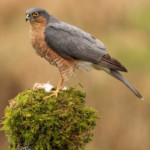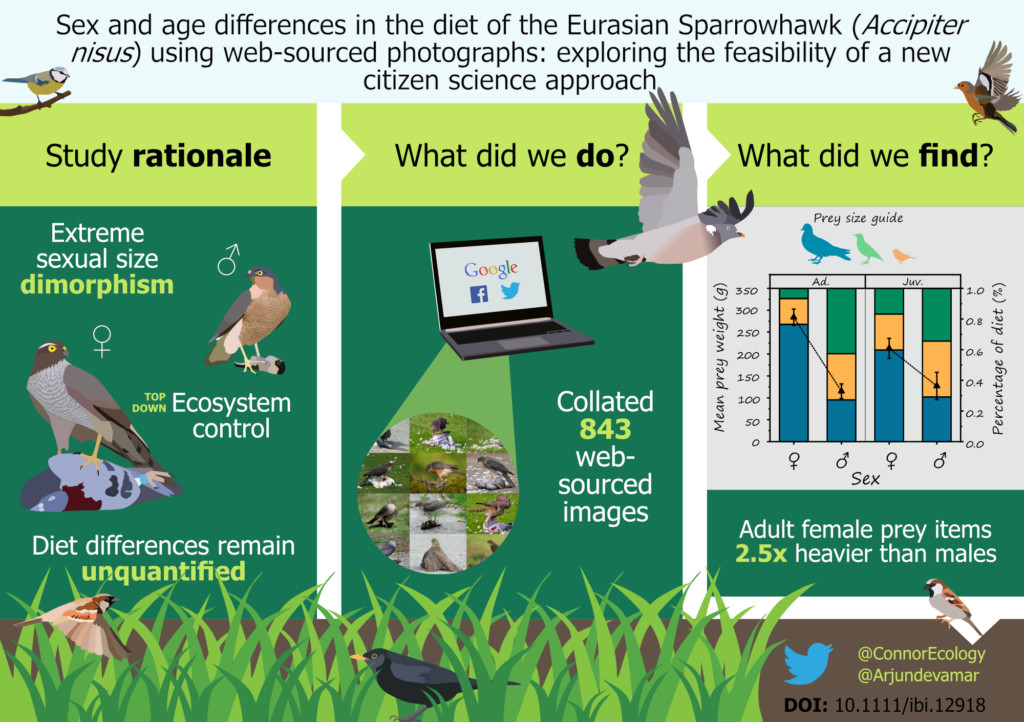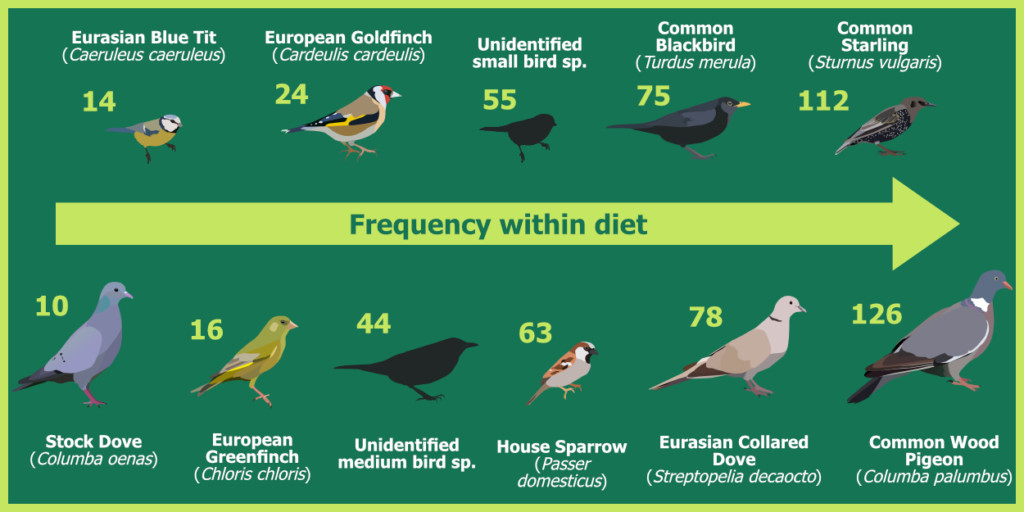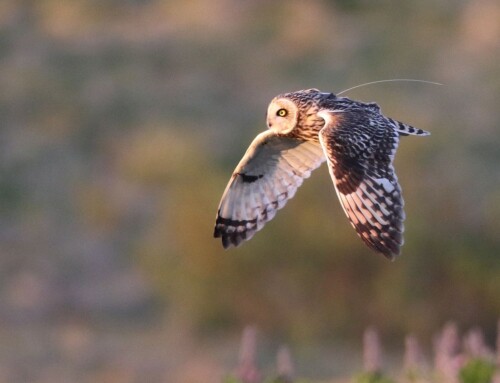LINKED PAPER
Sex and age differences in the diet of the Eurasian Sparrowhawk (Accipiter nisus) using web-sourced photographs: exploring the feasibility of a new citizen science approach. Panter, C.T. & Amar, A. 2021. IBIS. DOI: 10.1111/ibi.12918 VIEW
 Background behind the research
Background behind the research
Many birds display sexual size dimorphism where one sex is bigger than the other. Such differences can subsequently affect prey choice between the sexes. For ornithologists, making sense of diet differences is fundamental to fully understand the ecology of a species as this can have substantial implications when examining a species’ response to environmental change. Diet differences may also be a function of age due to a lack of hunting efficiency, foraging experience or prematurity of vital body parts used for feeding. As scientists our understanding of these differences is often hampered by the difficulty of obtaining diet data for younger non-breeding birds, since most studies tend to focus on breeding adults at their nests.
Within raptor research, usual methods to study diet (e.g. prey remains or pellet analyses) are often biased toward the breeding season or at least to breeding individuals. These methods tend to only capture prey brought back to the nest and often do not assign prey items to either sex or age group. Cameras and hides also suffer some of the same limitations and are invariably restricted to sampling a very small proportion of the population (e.g. breeding pairs).
The only method that has been able to identify sex-related diet differences is the use of VHF radiotelemetry coupled with activity sensors fitted onto the backs of Northern Goshawks (Accipiter gentilis) (Rutz 2003) or using dynamic GPS-GSM tags on Martial Eagles (Polemaetus bellicosus) (Hatfield 2018). However, such an approach only provides data for tagged individuals and requires high financial and time-investments; making it non-accessible for many researchers especially those from low-income countries.
The use of web-sourced photographs is potentially a new method to examine raptor diet overcoming several pre-existing limitations and has previously been used to explore geographic variance in the diet of Martial Eagles across Africa (see Naude et al. 2019).

Figure 1 A young female Eurasian Sparrowhawk with a Common Wood Pigeon kill in England | John Dyson | CC BY 2.0
We wanted to extend the work of Naude et al, to a sexually dichromatic species also displaying sexual size dimorphism. Therefore we applied this method to the Eurasian Sparrowhawk (Accipiter nisus) throughout the United Kingdom. Understanding diet differences is of particular interest in sparrowhawks due to the species’ high degree of sexual size dimorphism, which is arguably the largest of all raptors (Newton 1986). Photographs were obtained of sparrowhawks on prey from various online sources using the free application MORPHIC (Leighton et al. 2016), photograph repository websites together with the social media sites Facebook and Twitter.

Figure 2 Visual abstract of our study.
The majority of our photographs were sourced from the website BirdGuides totalling 355 (42%) photos. This was followed by MORPHIC (218; 26%), Facebook (144; 17%), Twitter (78; 9%), iNaturalist (34; 4%) and Macauley Library (14; 2%).
In total, we obtained 843 photographs of sparrowhawks with prey. From these, 568 (67%) were adults (312 male; 256 female) and 275 were juvenile (96 male; 179 female) birds.
On average, adult female prey were two and a half times heavier than prey of adult males. For juvenile sparrowhawks, this difference was less strong, average female prey weights were only around one and a half times heavier than juvenile males.
Our method also allowed us to identify key sparrowhawk prey items across the species’ range in the United Kingdom including: Common Wood Pigeon, Common Starling, Eurasian Collared Dove, Common Blackbird, House Sparrow, European Goldfinch, European Greenfinch, Eurasian Blue Tit and Stock Dove.
What did we find?

Figure 3 Key prey species within the sparrowhawk diet throughout the United Kingdom. Numbers represent the frequency of each prey species.
You may be thinking – what about prey size bias? Surely people are more likely to photograph hawks with larger prey items. To explore this issue we estimated potential prey size bias for each size class (small, medium and large prey). To do this we looked at videos of sparrowhawks killing and processing different sized prey items, recording how long they spend during different stages of prey processing and how often these same stages appeared in our collated photos. From this we estimated that there may be some bias. With our method, we suspect that medium and large prey items may be overestimated by 72% and 25%, relative to small prey items, respectively. This bias may influence some of our findings, however, other methods exploring diet are also known to be biased toward larger prey items (see Oro & Tella 1995; Redpath et al. 2001 for examples).
Implications of our results
For years, sex-related differences in sparrowhawks have been inferred mostly from personal observations. Our study is one of the first to quantify such differences and is unique in its ability to examine the diet of juvenile birds; an aspect of avian dietary studies that has proven difficult to accomplish using traditional approaches due to lack of data or inability to ascribe prey to individuals.
As with nearly all methods within ecological research our study is not without its limitations. We attempted to estimate a potential prey size bias which may have confounding implications on our results and the majority of our photographs came from gardens which may only sample the diet of the urban sparrowhawk population. Furthermore, we initially explored this approach across the entire species’ range but found that the UK provided the largest number of useable photographs –proof that we are a nation of birdwatchers!
Despite this, our method worked well and provided unique insights into the demographics of the sparrowhawk diet across the UK. The transferability of our approach is vast – but relies heavily on the study species being well-sampled and easily visually identified. Nevertheless, we have shown that with the help from the online British ornithological community, novel aspects of a top avian predator’s diet can be determined requiring little investment other than time.
References
Hatfield, R.S. 2018. Diet and space use of the martial eagle (Polemaetus bellicosus) in the Maasai Mara region of Kenya. Theses and Dissertations – Forestry and Natural Resources 44.
Leighton, G.R.M., Hugo, P.S., Roulin, A. & Amar, A. 2016. Just Google it: assessing the use of Google Images to describe the geographic variation in visible traits of organisms. Methods in Ecology and Evolution 7: 1060–1070. VIEW
Naude, V.N., Smyth, L.K., Weidemanm, E.A., Krochuk, B.A. & Amar, A 2019. Using web-sourced photography to explore the diet of a declining African raptor, the martial eagle (Polemaetus bellicosus). The Condor 121: 1–9. VIEW
Newton, I. 1986. The Sparrowhawk. London: A & C Black, 112.
Oro, D. & Tella, J.L. 1995. A comparison of two methods for studying the diet of the peregrine falcon. The Journal of Raptor Research 29: 210–213. VIEW
Redpath, S.M., Clarke, R., Madders, M. & Thirgood., S.J. 2001. Assessing raptor diet: comparing pellets, prey remains, and observation data at hen harrier nests. The Condor 103: 184–188. VIEW
Rutz, C. 2003. Assessing the breeding season diet of goshawks Accipiter gentilis: biases of plucking analysis quantified by means of continuous radio-monitoring. Journal of Zoology 259: 209–217. VIEW
Image credit
Top right: Male sparrowhawk with prey | John Purvis | CC BY-NC-SA 2.0
If you want to write about your research in #theBOUblog, then please see here.




